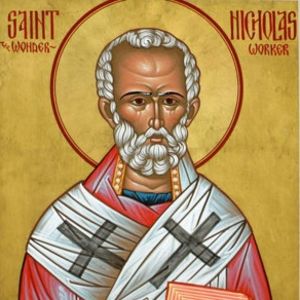Tis the season to stuff our stockings, clean our chimneys, and leave out milk and cookies; it’s time for Santa’s big show. Much of the holiday season is centered on this magical character who has become a world-icon for Christmas but do you know who Santa really is?
The beloved Santa has a history dating back to the third century; the rumor of him being hundreds of years old is true. In 280 AD, in Patara (now known as Turkey), a monk named Nikolaos of Myra was born. Nikolaos was a rich priest that would later become a bishop. His comfortable financial situation allowed him to travel and help those in need. He travelled around the region of Asia Minor and secretly left gifts because he did not want the receiver to know who he was, and he did not want the credit or praise. Nikolaos simply wanted people to enjoy what he was able to give and was not looking for anything in return. In other words, his gifts were without strings.
During his rule from 284 – 305 AD, Roman Emperor Diocletian had mandated that all of his people worship him as a god, but Nikolaos stayed true to his beliefs and refused. Outraged, Diocletian warned all of the Christians that if they did not obey his orders, they would be imprisoned. Nikolaos was imprisoned for more than five years until the new Emperor Constantine came to power and freed all of the Christians. He continued to live his life by secretly giving gifts and doing good deeds. He was made a saint in the eyes of the Catholic Church because of his dedication to his faith. He became known as Saint Nicholas nearly 200 years after his death.
Nikolaos became very popular, and was known as the protector of children and sailors. Many legends are attached to him that may stand as the basis for some traditions that we still practice today. One of the most famous involves the tradition of stockings. While the stockings of three women were left out to dry, Nikolaos left gold coins in them because their father was too poor to provide a dowry so that they may be married.
In the fourth century, Dec. 7 was celebrated as a feasting day in honor of St. Nicholas. Around this time, Pope Julius I gave a date for the celebration of Jesus’ birth. These two dates became closely connected, because St. Nicholas would visit the homes of children on Dec. 25 and bring gifts.
In Holland, St. Nicholas remained very popular, far beyond his popularity in Europe that died out after the Reformation. In honor of St. Nicholas, the Dutch practiced gift giving during Christmas, referring to him as Sinter Klass.
The adoration for St. Nicholas was brought to North America after the Revolutionary War. He was popularized by Washington Irving, who referred to St. Nicholas as the patron saint of New York in his book “The History of New York,” published in 1809.
Companies started advertising St. Nicholas in their stores for Christmas shopping in 1820, although Christmas shopping had already been a popular activity in America before this time. Throughout the rest of the nineteenth century, St. Nicholas transformed into “Santa Claus” by the help of famous artists Thomas Nast and writer Clement Clarke Moore, who wrote “The Night Before Christmas.” These two people are credited with providing Santa with a more concrete identity and personality that is similar to the one we hold today. Nast’s pictures depicted Santa as living in the North Pole, illustrating Santa’s workshop where he built toys and kept his list of names of children who were naughty or nice.
The poem was crucial in developing who Santa Claus is and what he does. In the poem, Moore explains that Santa flies in a sleigh with eight reindeer, going from house to house, sliding down the chimney, and leaving gifts in the stockings set by the fireplace.
By 1920, Santa Claus became more standardized and took on a consistent look: red suit, chubby, and a cheery nose. His colors were made permanent through the Coca Cola commercials that always showed him in white and red.
Rudolph the Red-Nosed Reindeer became popular in the late 1930s by Robert L May. His brother-in-law Johnny Marks wrote the classic song, and to this day Rudolph is almost, if not just as, popular as Santa Claus himself. Other characters, such as Frosty the Snowman, have been invented since.
To this day, Santa Claus is celebrated with traditions that go all the way back to Nikolaos. In recent years, there has been a growing amount of skepticism surrounding Santa’s ability to visit so many houses in so little time. Regardless, St. Nick still remains a world-wide Christmas icon.
Through his history, we can see that Santa has always been a giving and kind person. He has stood the test of time, and many of the traditions we celebrate today are similar to ones from centuries ago.

